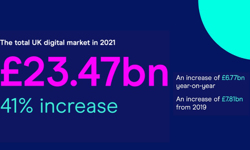In 2015, three quarters of publishers (71%) are expecting to recruit additional staff – the highest percentage expecting to increase their digital staffing levels seen since the Census survey began in 2003, and evidence of buoyant prospects ahead in the digital sector. The rise in programmatic trading means it is now a key investment area for publishers in terms of recruitment and skills development. However, it also remains the most difficult area in which to recruit. This year, publishers also expect to recruit more ‘traditional’ roles, such as editorial and content creation, audience development and business development.
The survey, carried out in February this year by AOP, suggests that a healthy looking 19% is the average rate of digital ad revenue growth that publishers expect to see in 2015, higher than the anticipation of the previous year, which was set at 16%. A third of this revenue is likely to come from mobile and tablet. Of course, we should always be aware of averages and there is a mixed expectation in the market as there was in 2014, now with 57% of publishers expecting growth of less than that 19% average, whilst 43% are more bullish about their prospects and see growth in excess of 20% this year.
The Organisation Census is now in its seventh year and has evolved over time to give a deeper view of the key drivers within the digital business of many of the UK’s leading publishing companies. It acts as a benchmark for the digital publishing industry in terms of where publishers are currently at and also captures their intentions for development over the next twelve months. A total of 32 organisations, representing well over 700 publisher brands and publications, from AOP Board, Associate and Affiliate membership completed the survey this year.
Once again, the digital publishing industry will continue to innovate, and new product launches remain high on the agenda in 2015, with three quarters of publishers (76%) expecting to have new product in the market this year, and nine out of ten looking for growth from core products, both consistent with expectations from the 2014 Census. The appetite for acquisition appears stronger, with 18% of publishers expecting to acquire this year, compared to 14% in 2014.
In terms of international intentions, we are seeing less expectation of expansion year-on-year; one in five publishers are looking to launch into new markets and almost one in three to grow their core business overseas (29%). Year-on-year, a growing amount of publishers are seeing very significant international traffic growth (32%), and also very significant international revenue growth (24%).
Mobile growth
Has the year of mobile finally arrived? Estimates for this year would lead us to say most certainly; 82% claim a ‘major increase’ in mobile traffic over the last twelve months, up from 71% for the previous twelve month period.
Tablet driven traffic also grew with 44% claiming a ‘major increase’; this is healthy, but slowing on 2014’s 60%. This might suggest differing usage behaviour between smartphones and tablets, but combined and compared to the 18% of publishers who saw a ‘slight decrease’ in desktop traffic (9% in 2014), there is definitely a consumer behaviour shift towards portable devices. Perhaps unsurprisingly, given the consumer shift to portable devices, responsive design tops the list for business expansion this year, up from 15% to 65%. It has also become 2015’s highest priority.
Four in five publishers will be looking to increase paid-for elements in their portfolios, a similar level to last year. Online events are where publishers are setting their sights to increase paid elements of their portfolios, up 21 percentage points year-on-year, whilst in overall terms, one in two publishers expect to increase paid elements on core websites compared to one in four on either tablet or smartphone apps.
Increased staffing levels
Building on last year’s impressive 65% of publishers claiming staffing levels would increase, 2015 has achieved a new high of 71%. This reflects the increasing importance of digital portfolios. There has been a 20% increase in intention to grow staffing over the last six years. This year, the focus for recruitment is on programmatic with ad sales returning as a priority after 2014’s dip, and analytics replacing database and data analysis in the top 3. 2015 also sees a return of focus on more traditional roles such as editorial / content, audience development and business development.
In terms of actual skills development, programmatic also leads the way, but again ad sales and business development feature highly. The area publishers are finding most difficult to recruit in is, again, programmatic! In the majority of cases, around 75%, editorial, sales and managerial positions work in an integrated fashion across traditional and digital roles.
In-house development
This year will see an increase in in-house development. In-house spend this year will be 72%, compared to 2014’s 62%. The majority of publishers (94%) are committed to growing their overall investments in technology (up from 89% in 2014). Most publishers (96%) are aiming to increase their investment in data (up from 89% in 2014), followed by responsive design at 85% (up from 76% in 2014). In light of AOP members’ feedback this year, the area of data management was introduced and is the area most likely to see an increase in technology partnerships, now clearly ahead of mobile and apps.
Data storage and protection were overall considered to be satisfactory, but with some room for improvement. However, in the areas of collection and handling, only around one third felt their approach was satisfactory. In terms of usage of the data held, 80% considered this to be the area where most development was required.
The greatest shift in revenue priorities for publishers in the next twelve months is native advertising, with nearly two-thirds (63%) citing it as a priority, just behind programmatic at 70%. Overall, 77% of publishers still view direct sales as the top priority for the next year. The premium programmatic sell is also predicted to increase this year to 68% (60% in 2014).
Challenges
Although this year’s Census shows a positive outlook for 2015, publishers continue to recognise the challenges facing their businesses. The ever changing nature of the digital environment, and the technology which powers it, have delivered the top two challenges for 2015, both new this year; viewable impressions and programmatic trading.
On a day-to-day operational note, people retention has grown as a challenge from last year, now 34%, up from 24% in 2014. The changing pattern of user behaviour has also introduced a new challenge for 2015; migrating revenue to mobile has been identified as a focus by almost a third of organisations (31%).
Changing the fundamental business model will also be a challenge for 2015 with both the need to migrate to a digital first approach and how to monetise subscribers and registered users being identified as priorities for this year.
The 2015 Organisation Census paints a positive picture for the online publishing industry in terms of investment, recruitment, and revenue growth. Challenges around advertising stem primarily from technology, and we will continue to work alongside other industry bodies to support the position of premium publishers in the UK.












